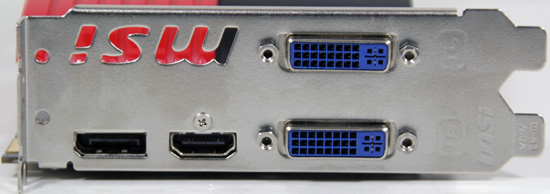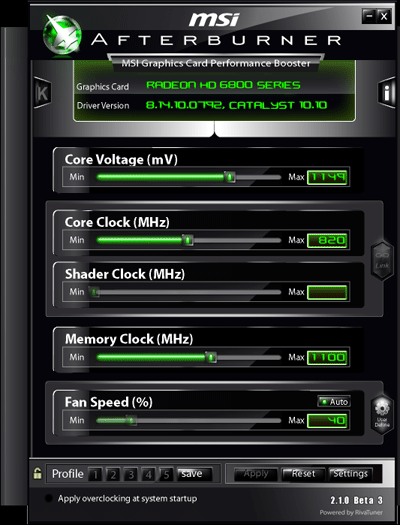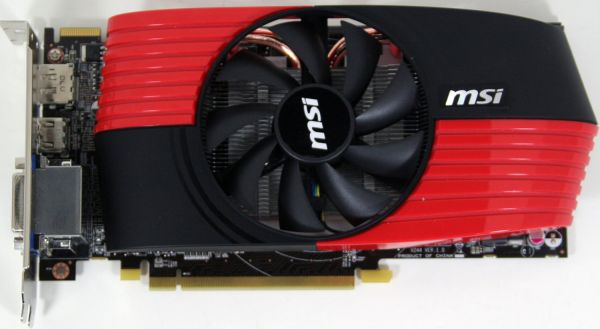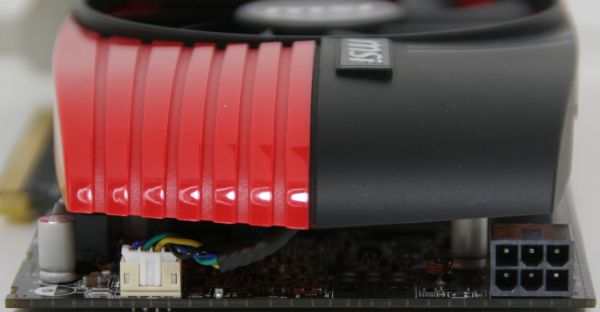AMD Radeon HD 6850 Overclocking Roundup: Asus, XFX, & MSI
by Ryan Smith on November 8, 2010 12:40 AM ESTMeet The MSI R6850 OC
The final card in today’s roundup is MSI’s R6850 OC. The R6850 OC is one of the first 6850s being released with a significant overclock, with MSI releasing it at 820MHz core and 1100MHz (4400MHz effective) memory, a 45MHz (5.8%) core and 100MHz (10%) memory overclock respectively. Besides the overclock, the card is identical to MSI’s existing R6850, using the same PCB and cooler as its stock-clocked counterpart.
Starting with the PCB, MSI is also using a non-reference PCB, this time using a shorter 8.5” PCB. In fact it's the same PCB as on the XFX card, leading us to believe that this is an alternative 1x DisplayPort PCB from AMD. In any case, because it's the same PCB as the XFX it means it's sharing the same design flaws: MSI has kept the PCIe power sockets on the rear of the card, so the practical length of the card is longer. Furthermore in the case of the MSI card, the card’s plastic shroud hangs over the end of the card, making the card 9” long in practice. As a result the end-user benefits of the shorter PCB are more or less wasted.
Attached to the PCB is MSI’s cooler, which bears a striking resemblance to Asus’s DirectCU cooler. Here MSI is using a pair of copper heatpipes to transfer heat from the baseplate to an aluminum heatsink that runs most of the length of the card. In the center is an 80mm fan providing airflow for cooling, and on top of that a shroud to direct airflow out of the front and the back of the card. Compared to the Asus DirectCU cooler, the biggest differences are that MSI is using a larger fan and copper heatpipes in place of aluminum heatpipes.
As for the port configuration, MSI is using the same configuration as both XFX and Asus: two DVI ports, one HDMI port, and one full-size DisplayPort, meaning the card can drive up to 5 monitors with a DP hub.

For the R6850, MSI’s ace in the hole is the software rather than the hardware. The R6850 comes with MSI’s fantastic Afterburner software, which comes with allows overclocking and monitoring, and on the R6850 it even allows voltage modification. While MSI makes this software available for use on non-MSI cards, we always make it a point to tip our hat in their direction as Afterburner continues to be the gold standard in overclocking software.

Rounding out the package is the usual collection of odds & ends: a quick-start manual, driver/utility CD, molex-to-PCIe power adaptor, a long CrossFire bridge, and a DVI-to-VGA dongle. Unfortunately we don’t have pricing information for the R6850 OC at this time, but we’ve already seeing the stock-clocked version at around $190, so we’d expect the R6850 OC to go for around $200, a $20 markup over the AMD MSRP for a reference card and roughly in-line with other factory overclocked cards. Meanwhile on the support side of matters, MSI is providing a 3 year warranty with the card.


















93 Comments
View All Comments
Mr Perfect - Monday, November 8, 2010 - link
AT normally tears the cooler off to examine the card, and then dissects the cooler itself too. Neither 6800 article has done this though. It should be an even bigger priority when we're comparing non reference cards that are competing purely on their unique designs. Are these cards on loan? Do they have to be returned in the same condition they where received? If so, I say just ship them back without reviewing them. :PI just came from XBitLabs, where they did a proper teardown of both a stock 6850 and 6870, and that Asus card looks a lot like the stock 6870 board. It has the two top mounted PCIe power connectors, and the VRMs appear to be between the GPU and IO ports. I would not be surprised if it really was a 6870 PCB. Check it out!
khimera2000 - Monday, November 8, 2010 - link
I appreciate the review, it looks alot less of a hot article as the last one, and its clear that a good amount of effert went into this article just by the comments AT left, and the way the article was written.I was also wondering when will the review of the higher end 6xxx card be availabe?
Cali3350 - Monday, November 8, 2010 - link
A lot of Doom and Gloom here about the OC cards. Let me try and tell you, Ryan and Anand, what I think the people want as a majority:1. Never use OC'd cards in a initial review. Ever. You guys, quite frankly, should have known this and the flak you are getting for using it is deserved imo. Nvidia conned you guys into making their cards unfairly better than the competition in the main review article of a major launch and you fell for it. That article will likely get much more readership than any roundup, and is likely to be looked up in higher numbers down the line. You played that one like a PR branch of Nvidia and you made people angry (imo rightly so). Dont ever do this again. Do not review anything but stock clocks in your GTX 580 review tommorow, and dont you dare use a overclocked anything in your upcoming Cayman review either.
2. Always use OC'd cards in your comparisons. This a COMPARISON article of AIB's and the products they are offering. Ofcourse we want to see how a overclocked 460 compares to a overclocked 6850, this is the article where we go over what is out there in the retail market, not what is officially supplied by the creators. This article loses a lot of value without a 460 OC'd in it.
Launch articles = what we are getting from the creators of the product.
Comparison articles = what we are buying in the real world.
I love this site, and I do not think your biased, but I wont defend you over the 68XX review either.
AnandThenMan - Monday, November 8, 2010 - link
I agree with what you are saying here. The problem is, the genie is out of the bottle. Anandtech should not let the 68xx review stand as is, the FTW results should be removed, and all references to it. And if that is not done, then overclocked AMD cards must be included in all future reviews, no exceptions. In fact, Anandtech should accept a hand picked, delivered to their door card from AMD.If neither are done, then I would question all results published here, there is a credibility problem to say the least. You can't start picking and choosing how reviews are done depending on the hardware. That is exactly why policies are in place. Sadly that policy was ignored.
Jamahl - Wednesday, November 10, 2010 - link
This.Ryan Smith and Anand deserve the fallout over this. They brought it on themselves as does any site that shifted their goalposts in the past few weeks.
Dwebtron - Monday, November 8, 2010 - link
I'm super interested in this one, as I'm holding on to mine... but it never appears in the charts?RaptorTek - Monday, November 8, 2010 - link
Its really the immature fanboys that cant handle seeing their company/card lose that make a stink about including the FTW OC cards in the mix. It makes them feel insecure about themselves and their decisions on being a fanboy for which they decided to spend their hard earned money on. When it comes down to it, the more data we have available the better the decisions we can make on what really is the best hardware for the price. Having the FTW 460 1gb in the stock 6850/6870 article was good since it showed what the contending cards possibilities were. Including the FTW 460 1gb in this OC article would of been even more relevant for side by side comparisons. I would hope Anandtech can see that even if some of "the readers" complain about these things, its really for the best in the logical comparison of these cards.
El_Capitan - Monday, November 8, 2010 - link
Indeed. Why would any logical person WANT LESS data?Fanboy: My HD 6850 that I bought for $189.99 is better than a stock GTX 460 1GB you purchased for $239.99, and overclocks higher!
Realist: I bought by GTX 460 1GB for $189.99 and it overclocks to 1015MHz without unlocking the voltage, what are you talking about?
Fanboy: AnandTech doesn't show that, so it's not relevant!
Realist: You're retarded.
Fanboy: You're an Nvidia fanboy!
Realist: I also own a HD 5870 2GB that I bought for $250.
Fanboy: Yeah, right, whatever!
Realist: ...
Fanboy: Stupid fanboys, they think they know everything.
Realist: :Facepalm:
AnandThenMan - Monday, November 8, 2010 - link
You both completely missed the point, and sounded childish and fanboy-ish in the process.jsrivo - Monday, November 8, 2010 - link
From what I've read, the OCed cards are reaching 800-900MHz on average, and claiming that 1015MHz is realistic for most buyers is a bit fanboyish, in my opinion.